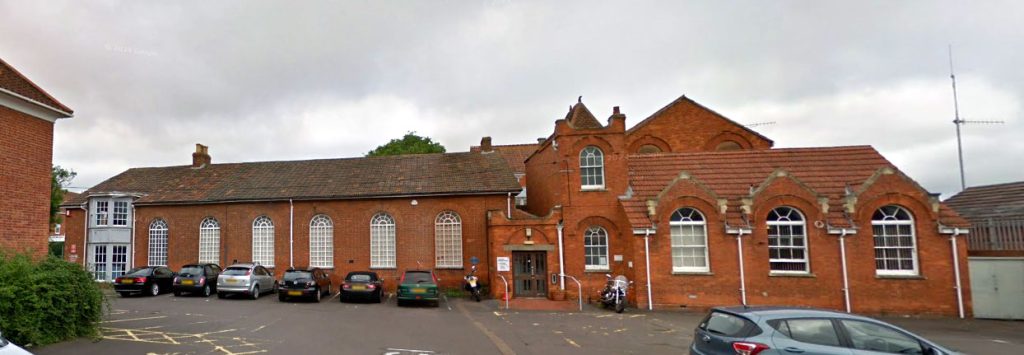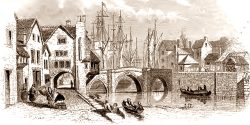
The creation of the West Street School prompted a wider discussion about education in the town of Bridgwater. The following summary is a discussion from the Bridgwater Mercury of 31st October 1860 on the future of Dr Morgan’s School, offers some fascinating insights and attitudes towards education and held by some the town’s leading townsmen. Notes kindly supplied by Clare Spicer.
A special meeting of the trustees of this charity was held in the Clarence Assembly Room on Thursday afternoon. The Mayor presided, and there were also present the Revs J.C. Collins and J.W. Robinson, Messrs John Browne, G.S. Poole, R. Smith, C.B. Mogg, J.I. Sealy, R.R.Woodland, S.B. West, J.R. Smith, J. Haviland, G. Parker and John Trevor.
First a mention was made of the election of seven scholars and the condition on the south wall of the playground, which had fallen as a result of a crowd of people eager to watch the town’s Rifle Volunteers drilling in the yard.
The main point of the meeting was to consider raising the fees to 4d a week, the proposal was put forward by G Parker with ‘much pleasure’. He felt that this would put Dr. Morgan’s in a position in line with what the founder had intended. The school was for ‘decayed inhabitants’ of Bridgwater, but Parker thought that this meant businessmen who had failed, not decayed labourers – the will of the founder had specifically excluded families on parish relief. He recalled how 50 years before the school had been held in King Square, and managed by a Mr Gill. After Gill came Mr Lansey, who charged six pence and also took on boarders. In his time a large schoolhouse was built on the Mount, and he expanded the school from sons of tradesmen to ‘children of the lower classes’ there being no alternatives. Since that time, however a school had been built in Eastover for boys and girls, then a girls’ National School, an infant school and a school in West Street for the poorer classes. Which meant Parker believed there was no longer a school in Bridgwater for the class of children the founder had intended. He wanted to the school to aim to be a good school for children of middleclass businessmen under its present head, Dr Lucette. He said that many of the children who now went to West Street School could afford to pay 2d a week, so they no longer needed to go to Dr Morgans. He also said that he was sorry the West Street School was given the name of ‘Ragged School’ as over the country, children who went to that sort of school were considered ‘Arabs’ and homeless outcasts, whereas the labourers of Bridgwater were respectable. Parker rounded off his speech by stating that the scheme was motivated by what he believed to be the general good.
Gabriel Poole seconded the motion, and he spoke for some time about the charity set up for Dr Morgan’s charity, its aims being to educate the ‘sons of decayed inhabitants of the borough of Bridgwater not receiving alms from the borough or parish’ where they would be ‘taught to write well, and to learn arithmetic, navigation, and mathematics’. Also he discussed other schools. West Street School was a good school, so it wouldn’t harm the poorer pupils from Dr Morgans to go there. He also felt it was important to have a good quality school for the children of tradesmen, in order to attract more tradesmen to the town. He affirmed he did not want to set rules for the class background of the pupils, just to raise the price of admission. He did fear the better class of family would be less likely to send their children to a school with pupils of the lower classes – he did not necessarily agree with this principle, but he affirmed that it existed and needed to be considered. He also wanted, in time, the number of borders to be expanded to 30 or 40 and use Mr Parker’s suggestion to be the foundation for more fundamental reforms.
The Rev. Robinson then said their role as trustees was to fulfil the wishes of the founder. The will included provision for the teaching of the principles of the Church of England and Ireland, English grammar, geography, mathematics, navigation, book keeping, land surveying, drawing, designing and other things. As the provision in the will seemed to be for middle classes he was inclined to agree with Mr Parker.
JL Sealy disagreed with G Parker, he did not want to alter the character of the school, and felt that the founder had intended Dr Morgans to be a school for pupils who could not afford high fees. This sounded very noble but he then went on to say that the pupils cast out from Dr Morgans would be forced to mix with the children of the Ragged School, which was intended for the very lowest class. He believed that 50 boys would be excluded by this fee increase. It would not be fair for them to go to the ragged school where the education was inferior.
Mr Lucette, the master of the school, said that he had canvassed the boys and thought that at least one half would definitely remain, maybe two thirds. The ones who would have to leave were the migratory ones who spent several months a year working in the brick yards or other places. (The implication was that they were no loss).
J Browne was against the motion, as opposite to the spirit of the school’s founding. Mr Gill had also run a second school for which a higher price was charged, as had Mr Lanley, whose expansion to around 200 boys had the intention of including poorer classes. However, he went on to say that he feared expelling pupils to the ragged school would be ‘a fatal mistake’: as people had contributed to the ragged school for the poorest children, not for the sort of children who went to Dr Morgans.
JR Smith then spoke. He was against the proposal. He did not believe the fee increase would achieve Parker’s objective. He was against moving one third of the school of the tradesman class, and as Mr Poole had observed that the disinclination of folk to let their children mix with those inferior to them, the rest of the school would be of the same class anyway. That same inclination would also prevent the parents of those expelled from the school from sending their children to the Ragged School. He said that the Ragged School ought to be occupied by children now roaming about the streets, who were outcasts of society, and there were children in Bridgwater like this by the hundred, enough to fill the ragged school. He said more in this vein.
Richard Smith (JR Smith’s brother) spoke next. He was in favour of the fee increase, but went on to speak forcefully about the West Street School. This is where he explained that the school in West Street was definitely not a ragged school. Smith said he was sorry to hear the remarks Mr Browne had made, as it implied that people had been tricked into giving money to the West Street School, when in fact they had been clear about the plans, and Mr Browne had been such a good supporter. If they thought that the West Street School was a ragged school, he asked them to put their hands in their pockets and pay all expenses (he hopefully banged the table at this point). He said more about why they had to charge fees and could no longer be a free school, and so were no longer a ragged school. (He may have felt that he had been badly let down by Browne and his brother).
There was more discussion and consideration of the fees charged at other schools, and then the motion to raise the fees to 4d a week was passed.
In essence, this discussion entailed them all wanting to make Dr Morgans a school with a good ‘class’ of children, but disagreed on the way to achieve it.
Dr Morgan’s would become a county-controlled grammar school in 1870. Its successor today is Haygrove School.
